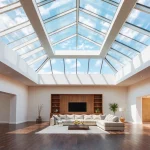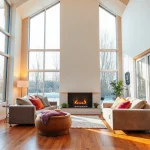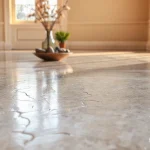Understanding the Space for Your Basement Home Theater
Creating an effective basement home theater design begins with carefully measuring your available space. This is crucial in ensuring your layout considerations align perfectly with your room’s dimensions. Begin by noting every detail, such as ceiling height and entry points, as they can significantly influence the room’s usability and comfort level.
Next, devise a plan that addresses both equipment placement and viewing areas strategically. It’s important to ensure there’s a natural flow between the equipment, seating, and walkways, avoiding any obstructions. Consider how the layout considerations can affect sound distribution and sightlines, optimizing the overall experience for viewers.
Have you seen this : Creative strategies to combat noise pollution in your apartment in birmingham city center
Furthermore, attention to space optimization goes beyond mere dimensions. In low-ceilinged basements, selecting compact seating or retractable projection screens can dramatically improve space efficiency. Ensure to incorporate accessible entry points and proper ventilation for an optimal viewing environment.
By prioritizing both basement home theater design and layout considerations, your project is more likely to be successful, resulting in a space that is both functional and inviting. This structured approach aids in overcoming potential spatial challenges and ensures your home theater is both pleasing and practical.
This might interest you : Top strategies for maintaining a historic garden in your grade ii listed property in london
Acoustics and Soundproofing Techniques
In crafting a superb basement home theater, soundproofing plays a pivotal role. Basements often pose unique challenges with sound due to their structural nature. To mitigate sound leakage, suitable soundproofing materials such as acoustic panels, mass-loaded vinyl, and resilient channels are essential. These help in dampening noise and elevating the overall audio quality within the theater.
To further enhance the acoustics, incorporating various acoustic treatments is advisable. Bass traps can manage lower frequencies, while diffusers scatter sound waves for even distribution, contributing to a richer audio experience. These elements work together to refine sound clarity and depth, fostering a cinematic atmosphere.
Moreover, minimizing external noise interference is crucial. Sealing any potential air gaps and insulating HVAC systems can significantly reduce unwanted sounds from entering the theater environment. This approach ensures that the auditory focus remains on the film, free from distracting noises.
Addressing these strategies in your basement home theater design not only improves the audio quality but also transforms the space into a dedicated entertainment haven where sound is mastered, not just managed.
Lighting Solutions for an Immersive Experience
Creating the optimal lighting environment in a basement home theater is crucial for enhancing the viewing experience. Home theater lighting not only shapes the ambiance but also complements the projection considerations, ensuring that the visuals are sharp and vivid. To begin, select lighting fixtures that provide flexibility, such as dimmable LEDs or smart lighting systems. These allow you to adjust ambient lighting based on the requirements of different scenes.
For balanced illumination, aim to harmonize ambient and task lighting. Ambient lighting should softly wash the room, preventing harsh contrasts that strain the eyes, while task lighting highlights specific areas without disrupting the screen view. Consider using recessed lighting around the perimeter for soft, uniform light distribution.
Moreover, effective blackout solutions are essential in enhancing projection quality. Light-blocking curtains or blinds can eliminate unwanted glare, providing a darkened room that boosts contrast and picture clarity. Additionally, colour-temperature-adjustable bulbs are advantageous, allowing you to tailor the warmth or coolness of the light to suit different viewing occasions.
Incorporating thoughtful lighting solutions elevates the atmospheric immersion of a basement theater, enhancing both comfort and functionality for viewers.
Selecting the Right Equipment
In creating a high-quality basement home theater, choosing the right home theater equipment is paramount. A well-chosen audio-visual setup can elevate the viewing experience by ensuring crisp visuals and immersive sound. Key components include screens, projectors, and speakers, forming the backbone of your entertainment system. It’s essential to match equipment to the room size and layout design to maximise performance. For instance, a projector and retractable screen might suit larger spaces, whereas an OLED TV could be ideal for compact areas.
Amplifying the audio experience involves selecting speakers that complement the acoustics of your basement. Consider a surround sound system or soundbars that can be discreetly integrated into the design.
Stay ahead with technology trends for potentially beneficial features such as 4K resolution and smart integration. Modern innovations can include voice control and streaming capabilities, adding convenience and flexibility to your setup. By investing in the right gear, you are laying the foundation for a cutting-edge home theater capable of delivering a cinematic experience. Therefore, keep abreast of advances in technology, ensuring your system stays relevant and adaptable.
Seating Arrangements and Comfort
When designing your basement home theater, emphasizing home theater seating is essential for comfort and functionality. Begin by determining the layout design that maximizes seating capacity while maintaining optimal sightlines for an immersive experience. Recliners with head and leg support are a popular option, promoting comfort during extended viewing sessions.
Consider flexible seating arrangements as they cater to different audience sizes and needs. Modular couches and movable chairs give the versatility to reconfigure the space for single viewers or larger gatherings. This adaptability can enhance user satisfaction and is particularly advantageous in mixed-use spaces.
In basements where space may be limited, efficient layout design involves placing seating strategically to balance social interaction with unobstructed views of the screen. Comfort is paramount; therefore, choosing plush materials and ergonomic designs can elevate the viewing experience. Integrating amenities such as cup holders or storage compartments can further boost comfort and user convenience.
Lastly, incorporate aisle space for easy movement, allowing viewers to enter and exit comfortably without disturbing others. By thoughtfully addressing layout design and comfort, basement home theaters can be transformed into inviting havens of relaxation and entertainment.
Navigating Local Regulations and Compliance
Before launching into your home theater installations, understanding local regulations and building codes is paramount. Each region may have differing requirements, especially concerning basement renovations. In Oxford, for instance, obtaining the necessary permits is a legal requirement before construction begins. Without them, you risk fines or needing to reverse unauthorized modifications. Thus, ensure you align your project with local stipulations to avoid future headaches.
Begin by consulting your local council or planning department to gather information about the specific permits required. This usually involves submitting architectural drawings and detailed plans of your proposed setup. Hiring knowledgeable local contractors with experience in navigating Oxford regulations can also be invaluable. Their expertise not only streamlines the approval process but helps ensure your home theater complies with safety standards and building codes.
Remember, addressing local regulations early facilitates a smoother renovation process and ensures long-term satisfaction. It can be an intricate task, but paying attention to these details saves you from potential issues and fosters a compliant, enjoyable basement oasis.
Visual Inspiration and Cost Estimates
Creating your ideal home theater starts with gathering home theater design ideas that align with your vision. Search online platforms, magazines, or visit local showrooms for a treasure trove of visual examples. These sources provide diverse styles, from minimalist setups to luxurious cinema-like experiences, helping you envision possibilities for your space.
Once you have a sense of style, consider a cost analysis for your desired setup. A basic DIY design might cost significantly less than a professionally installed luxury space, but may require more hands-on effort. For a DIY approach, investing in quality second-hand equipment and utilizing existing furniture can keep expenses manageable. Larger projects with custom installations will naturally increase costs; therefore, obtaining quotes from multiple contractors can optimize your budget and service selection.
To illustrate practicality and feasibility, explore case studies of local basements transformed into theaters. These examples offer insight into both the intricacies of the setup and potential financial commitments. Observing varied projects illustrates the wide range of options available, from budget-friendly designs to opulent, state-of-the-art underground cinemas, giving you a comprehensive view of your endeavor.
Trends in Basement Home Theaters
In the realm of basement home theater design, keeping up with current home theater trends can greatly enhance both aesthetics and functionality. Modern designs are increasingly focusing on sleek, technology-driven setups that prioritize user engagement and convenience.
Emerging modern designs are incorporating seamless integration with smart home systems, allowing users to control lighting, sound, and screen preferences through voice or remote applications effortlessly. This connectivity offers a personalized viewing experience, setting a new standard in cinematic immersion.
User preferences are shifting towards minimalistic and space-efficient designs. Compact seating arrangements complement sleek equipment setups, ensuring optimal use of space without sacrificing comfort or performance. In Oxford, there’s a notable trend towards using multi-purpose furniture to optimize smaller spaces, maintaining both style and utility.
Looking ahead, innovations such as virtual reality integration and enhanced streaming capabilities are predicted to redefine home entertainment. Future home theater trends may embrace even more advanced technologies, such as AI-driven customization and augmented reality, further enhancing the interactive experience. By staying ahead of these trends, homeowners can create dynamic and engaging theater environments that resonate with contemporary tastes and technological advancements.









